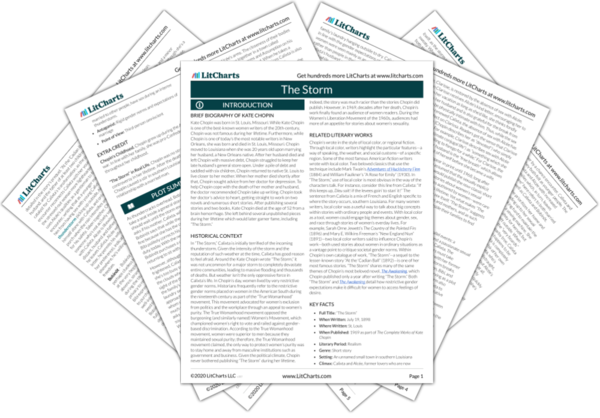“The Storm” details two parallel events: a tremendous thunderstorm and a passionate sexual encounter between Alcée and Calixta. The thunderstorm is so intense that all characters must take shelter. This leaves Calixta alone at her home with her former lover Alcée, who is traveling nearby when the storm breaks. Meanwhile, the thunderstorm leaves Calixta’s son, Bibi, and husband, Bobinôt, stranded at a store. Beyond serving as a plot device for situating each character, the thunderstorm also allows for a brief encounter between Alcée and Calixta to naturally emerge. Chopin uses the downpour as a narrative frame for sex between the two former lovers; as the thunderstorm intensifies, so does the physical action between Alcée and Calixta. Then, when the storm rolls out, the two lovers go their separate ways. In drawing a parallel between the sex and the storm, Chopin develops an allegory through the thunderstorm in which she implicitly argues that sexual desire is a part of human nature. Further, Chopin describes Calixta’s body through metaphors of nature, putting a fine point on the naturalness of women’s sexuality in particular.
Sex between Calixta and Alcée occurs in stages alongside the stages of the concurrent thunderstorm, with particular attention to how Calixta embodies each stage. “The Storm” details the normal stages of a thunderstorm: heat followed by cool gusts of wind with large droplets of water that intensify to sheets of rain before giving way to sunshine. Calixta’s body likewise runs through each of these stages alongside the storm itself: as the storm gathers, Calixta feels “very warm” and sweaty. When first encountering Alcée, Calixta is affected by both the wind and the sound of Alcée’s voice, breaking her from the heat “as if from a trance.” As the storm begins to intensify and Alcée first embraces her, Calixta’s body is described as “palpitating.” As the storm “roars,” Calixta laughs in delight of sexual pleasure. At each stage of the story, the changes in weather mirror a change in Calixta’s body. If the reader accepts that weather events are a natural part of life, they may also understand Calixta’s desire and pleasure as likewise natural.
Chopin also deploys weather-related metaphors to describe sex between Alcée and Calixta and nature-related metaphors to describe Calixta’s body. For instance, Chopin describes the act of sexual intercourse as the “crashing torrents,” or violent rainfall. The storm clears, with “growl of the thunder was distant and passing away,” just as the two lovers finish and slide into a state of “drowsiness and sleep.” After the storm, as Alcée rides away, Chopin describes how “sun was turning the glistening green world into a palace of gems” such that it mirrors Calixta’s “beaming face.” Chopin describes Calixta’s skin is a “creamy lily,” her passion “a white flame,” her eyes like “water,” and lips a “pomegranate.” While not exactly related to storm allegory, these descriptions fall in line with the general theme of sexual desire as a part of natural life. Again, if a reader accepts that weather occurs without any means of control, they may accept that sex between Calixta and Alcée is likewise an uncontrollable (and perhaps not immoral) consequence of human nature. Moreover, the story implies that because Calixta and Alcée are creatures within nature, the pair’s actions are simply a part of the natural order.
In “The Storm,” Chopin uses a thunderstorm as a plot device to bring two former lovers alone for a sexual encounter. By situating Alcée and Calixta within the event of the storm, Chopin implicitly argues that the sex between the two, even though they are married to other people, is a natural event. In other words, sex, like weather, is an uncontrollable expression of human nature. As such, through allegory, Chopin makes a broader comment on the naturalness of desire and sex. As Chopin ties the stages of the storm particularly close to Calixta’s feelings of attraction and describes her aroused body through metaphors of nature, Chopin stresses that women’s sexuality is a natural part of life.
Sex and Nature ThemeTracker

Sex and Nature Quotes in The Storm
Calixta, at home, felt no uneasiness for their safety. She sat at a side window sewing furiously on a sewing machine. She was greatly occupied and did not notice the approaching storm. But she felt very warm and often stopped to mop her face, on which the perspiration gathered in beads. She unfastened her white sacque at the throat.

Unlock explanations and citation info for this and every other The Storm quote.
Plus so much more...
Get LitCharts A+“My! what a rain! It’s good two years sence it rain’ like that,” exclaimed Calixta as she rolled up a piece of bagging and Alcée helped her to thrust it beneath the crack.
He pushed her hair back from her face that was warm and steaming. Her lips were as red and moist as pomegranate seed. Her white neck and a glimpse of her full, firm bosom disturbed him powerfully. As she glanced up at him the fear in her liquid blue eyes had given place to a drowsy gleam that unconsciously betrayed a sensuous desire.
And the first free breath since her marriage seemed to restore the pleasant liberty of her maiden days. Devoted as she was to her husband, their intimate conjugal life was something which she was more than willing to forego for a while. So the storm passed and every one was happy.











